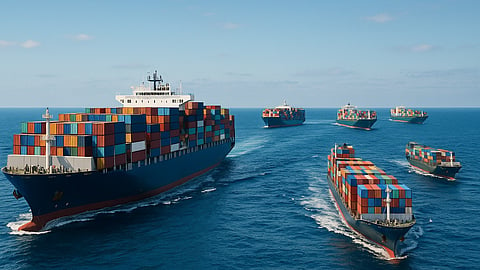Shipping Lines Face Mixed Q3 as Volumes Rise but Margins Tighten
The third quarter of 2025 delivered a mixed performance for the world’s major container-shipping lines. Volumes continued to rebound across several regions, but freight-rate pressure and rising operating costs cut into margins.
The result is a quarter that shows momentum on the demand side but clear signs that carriers are struggling to protect profitability in a more competitive, post-pandemic market.
Maersk Posts Solid Results
Maersk recorded one of the stronger quarters among global carriers. The company posted US$14.2 billion in revenue, down about 10% from a year earlier but ahead of expectations due to steadier rates and higher volumes.
EBITDA came in around US$.7 billion, and improved operational efficiency allowed Maersk to raise the lower end of its full-year guidance. The carrier highlighted growth across Europe, Africa, Latin America and West-Central Asia, which helped offset softer demand into the United States. It now expects global container-market growth of roughly 4% for 2025.
COSCO Takes a Hit
COSCO Shipping Holdings faced one of the steepest profit drops among the major lines. Q3 net profit fell about 55% year-over-year to CNY 9.53 billion, while revenue dropped more than 20%. The company handled more cargo - volumes rose about 6 percent across the first nine months - but the collapse in freight rates overshadowed the gains.
Global Shipping Sees Diverging Fortunes Across Trade Lanes
With the China Containerised Freight Index falling nearly 40% year-on-year in Q3, COSCO’s results underline how fragile margins become when pricing erodes faster than volumes grow.
Hapag-Lloyd Sees Higher Volumes but Lower Earnings
Hapag-Lloyd reported nine-month profit of US$983 million, about half of last year’s level. EBIT fell 55% to US$940 million despite a 9% increase in transport volumes to 10.2 million TEU.
The company pointed to higher operating costs and ongoing geopolitical disruptions, particularly in the Red Sea, as key pressures. With conditions softening, Hapag-Lloyd trimmed the upper end of its full-year EBIT guidance to reflect the tougher rate environment.
CMA CGM and Wan Hai Navigate the Same Rate Squeeze
While detailed Q3 financials from CMA CGM and Wan Hai are less widely available, both companies are operating in the same climate: stronger volumes, but margins under strain.
CMA CGM signaled that market conditions remain challenging despite solid operational performance. Wan Hai, which relies heavily on competitive intra-Asia trades, continues to face intense downward rate pressure.
Stand Out Themes Across the Shipping Industry
The first theme is volume recovery. Exports out of China and flows across emerging markets continue to strengthen, but rates are not rising with them. Capacity growth and a return to pre-pandemic pricing norms continue to hold rates down.
The second theme is cost pressure. Fuel, labour, port fees and rerouting costs tied to geopolitical risks all rose during Q3. Red Sea-related diversions, in particular, continue to lengthen voyages and inflate expenses.
The third theme is guidance adjustments. Carriers with strong cost control or diversified business lines, like Maersk, are cautiously raising guidance. Others, such as COSCO and Hapag-Lloyd, are lowering expectations as the market normalizes.
Modest Growth, Persistent Margin Pressure
The outlook for the remainder of 2025 points to moderate demand growth - likely around 3 to 5 percent globally - with ongoing pressure on freight rates.
New tonnage continues to enter service, and while rerouting helps absorb capacity, it is not enough to tighten supply meaningfully. Cost control will be the main differentiator among carriers. Diversified firms with logistics and terminal operations may weather the environment better, while pure ocean carriers remain exposed to rate swings.
Predictable Rates but Higher Operating Risk Ahead
Geopolitical tension, trade-policy uncertainty and labour risks will continue to shape schedules and profitability through Q4. The industry remains profitable, but the extraordinary gains of recent years are long gone. Q3 confirms the new normal: stable demand, lower rates and a constant fight to manage rising costs.
Read More: Container Shipping Schedule Instability Surges Despite Looming Overcapacity


